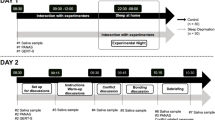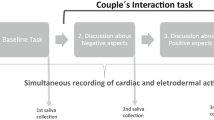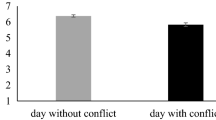Abstract
A sample of 80 couples were videotaped discussing a marital conflict and were then grouped in 3 types according to their interaction behavior: both partners displaying predominantly negative behavior (N = 36 couples); both partners showing positive behavior (N = 26); and couples showing a symmetric behavior (one positive, one negative; N = 16). Positive or negative in this context refers to the empirically defined quality of speaker and listener skills by the Kategoriensystem Partnerschaftlicher Interaktion. Psychophysiological responses were measured 5 times, both before and after the conflict discussion. Participants rated their overall marital quality, the number of marital problems, and their actual cognitions and emotions. Overall responses to the conflict revealed a greater cortisol response in women than in men. Couples grouped according to their interaction style showed significant differences in cortisol responses: In couples with positive interaction, cortisol increased markedly, whereas couples with negative interaction showed a nonresponse, that is, a slight decrease expected with diurnal variation, although they rated the actual conflict discussion as “stressful” like the other groups of couples. We conclude that marital interaction directly affects physiological responses to a conflict depending on interaction quality.
Similar content being viewed by others
References
Axelrod, J., & Reisine, T. D. (1984). Stress hormones: Their interaction and regulation. Science, 24, 452–459.
Bohus, B. (1988). Limbic-midbrain mechanisms and behavioral physiology of interactions with CRF. ACTH, and adrenal hormones. In D. Hellhammer, I. Florin, & H. Weiner (Eds.), Neurobiological approaches to human disease (pp. 267–285). Toronto, Canada: Huber.
Brandenberger. G., Follenius, M., & Hietter, B. (1982). Feedback from meal-related peaks determines diurnal changes in cortisol response to exercise. Journal of Clinical Endocrinology and Metabolism, 54, 592–596.
Brandenberger, G., Follenius, M., & Muzet. A. (1984). Interactions between spontaneous and provoked cortisol secretory episodes in man. Journal of Clinical Endocrinology and Metabolism, 59, 406–411.
Burman, B., & Margolin, G. (1992). Analysis of the association between marital relationships and health problems: An interactional perspective. Psychological Bulletin, 112, 39–63.
Christensen, A., & Heavey, C. L. (1990). Gender and social structure in the demand/withdraw pattern of marital conflict. Journal of Personality and Social Psychology, 59, 73–81,
Dohrenwend, B. S., Dohrenwend, B. P., Dodson, M., & Shrout, P. E. (1984). Symptoms, hassles, social supports, and life events: Problem of confounded measures. Journal of Abnormal Psychology, 93, 222–230.
Ewart, C. K., Bumett, K. F., & Taylor, C. B. (1983). Communication behaviors that affect blood pressure: An A-B-A-B analysis of marital interaction. Behavior Modification, 7, 331–344.
Ewart, C. K., Taylor, C. B., Kraemer, H. C., & Agras, W. S. (1984). Reducing blood pressure reactivity during interpersonal conflict: Effects of marital communication training. Behavior Therapy, 15, 473–484.
Ewart, C. K., Taylor, C. B., Kraemer, H. C., & Agras, W. S. (1991). High blood pressure and marital discord: Not being nasty matters more than being nice. Health Psychology, 10, 155–163.
Fehm-Wolfsdorf, G. (1994). Streβ und Wahrnehmung: Psychobiologie der Glucocorticoide [Stress and perception: Psychobiology of glucocorticoids]. Bern: Huber.
Fehm-Wolfsdorf, G., Sohen, U., Amdt, R., Kem, W., Fehm, H. L., & Nagel, D. (1993). Auditory reflex Thresholds elevated by stress-induced cortisol secretion. Psychoneuroendocrinology, 18, 579–589.
Gottman. J. M. (1979). Marital interaction: Experimental investigations. New York: Academic.
Hahlweg, K. (1996). Fragebogen zur Partnerschaftsdiagnostik [Partnership Dianostic Questionaries]. Göttingen, Germany: Hogrefe.
Hahlweg, K., Reisner, L., Kohli, G., Vollmer, M., Schindler, L., & Revenstorf, D. (1984). Development and validity of a new system to analyze interpersonal communication: Kategoriensystem für partnerschaftliche Interaktion. In K. Hahlweg & N. S. Jacobson (Eds.), Marital interaction: Analysis and modification (pp. 182–198). New York: Guilford.
Hahlweg, K., Revenstorf, D., & Schindler, L. (1984). Effects of behavioral marital therapy on couples’ communication and problem-solving skills. Journal of Consulting and Clinical Psychology, 52, 553–566.
Hooley, J. M., & Hahlweg, K. (1989). Marital satisfaction and marital communication in German and English couples: A tale of two cities. Behavior Assessment, 11, 119–133.
Hops, H., Wills, T. A., Patterson, G. R., & Weiss, R. L. (1972). Marital Interaction Coding System MICS. Eugene: University of Oregon and Oregon Research Institute.
Janke, W., Hüppe, M., Kallus. W., & Schmidt-Atzert. L. (1988). Befindlichkeitsskalierung anhand von Kategorien und Eigenschaftswörtern. Würzburg: lnstitut für Psychologie.
Kiecolt-Glaser, J. K., Fisher, L. D., Ogrocki, P., Stooukt J. C., Speicher, C. E., & Glaser, R. (1987). Marital quality, marital disruption, and immune function. Psychosomatic Medicine, 49, 13–34.
Kiecolt-Glaser, J. K., Malarkey, W. B., Chee, M., Newton, T., Cacioppo, J. T., Mao, H.-Y., & Glaser, R. (1993). Negative behavior during marital conflict is associated with immunological down-regulation. Psychosomatic Medicine, 55, 395–409.
Kiecolt-Glaser, J. K., Newton, T., Cacioppo, J. T., MacCallum, R. C., Glaser, R., & Malarkey, W. B. (1996). Marital conflict and endocrine function: Are men really more physiologically affected than women? Journal of Consulting and Clinical psychology, 64, 324–332.
Kirk, R. E. (1982). Experimental design: Procedures for the behavioral sciences. Belmont: Brooks/Cole.
Kirschbaum, C., & Hellhammer, D. (1989). Salivary cortisol in psychobiological research: An overview. Neuropsychobiology, 3, 150–169.
Kirschbaum, C., & Hellhammer, D. H. (1994). Salivary cortisol in psychoneuroendocrine research: Recent developments and applications. Psychoneuroendocrinology, 19, 313–333.
Kirschbaum, C., Read, G. F., & Hellhammer, D. H. (1993). Assessment of hormones and drugs insaliva in biobehavioral research. Seattle, WA: Hogrefe & Huber.
Lassner, J. B., Matthews, K. A., & Stoney, C. M. (1994). Are cardiovascular reactors to asocial stress also reactors to social stress? Journal of Personality und Social Psychology, 66, 69–77.
Levenson, R. W., & Gottman, J. M. (1983). Marital interaction: Physiological linkage and affective exchange. Journal of Personality and Social Psychology, 45, 587–597.
Levenson, R. W., & Gottman, J. M. (1985). Physiological and affective predictors of change in relationship satisfaction. Journal of Personality and Social Psychology, 49, 85–94.
Malarkey, W. B., Kiecolt-Glaser, J. K., Pearl, D., & Glaser, R. (1994). Hostile behavior during marital conflict alters pituitary and adrenal hormones. Psychosomatic Medicine, 56, 41–51.
Mason, I. W. (1968). A review of psychoendocrine research on the pituitary-adrenal cortical system. Psychosomatic Medicine. 30, 576–607.
McEwen, B. S., de Kloet, E. R., & Rostene, W. (1986). Adrenal steroid receptors and actions in the nervous system. Physiological Review, 66, 1121–1188.
Mormede, P., Lemarie, V., Castanon, N., Dulluc, I., Laval, M., & Le Moal, M. (1990). Multiple neuroendocrine responses to chronic social stress: Interaction between individual characteristics and situational factors. Physiology and Behavior, 47, 1099–1105.
Munck. A,, Guyre, P. M., & Holbrook, N. J. (1984). Physiological functions of glucocorticoids in stress and their relationship to pharmacological actions. Endocrine Review, 5. 25–44.
Notarius, C. I., & Markmann, H. J. (1981). The couples interaction scoring system. In E. E. Filsinger & R. A. Lewis (Eds.), Assessing marriage: New behavioral approaches (pp. 112–127). Beverly Hills, CA: Sage.
Patterson, G. R., & Hops, H. (1972). Coercion, a game for two: Intervention techniques for marital conflict. In R. W. Ulrich & P. Mountjoy (Eds.), The experimental analysis of social behavior (pp. 151–179). New York: Appleton-Century-Crofts.
Patterson, G. R., & Reid, J. B. (1969). Reciprocity and coercion: Two facets of social systems. In C. Neuringer & J. L. Michael (Eds.). Behavior modijication in clinical psychology (pp. 133–177). New York: Appleton-Century-Crofts.
Revenstorf, D., Hahlweg, K., Schindler, L., & Vogel, B. (1984). Interaction analysis of marital conflict. In K. Hahlweg & N. S. Jacobson (Eds.), Marital interaciion: Analyses and modfication (pp. 159–181). New York: Guilford.
Sapolsky, R. M., Krey, L. C., & McEwen, B. S. (1986). The neuroendocrinology of stress and aging: The glucocorticoid cascade hypothesis. Endocrine Review, 7, 284–301.
Spanier, G. B. (1976). Measuring dyadic adjustment: New scales for assessing the quality of marriage and similar dyads. Journal of Marriage and Family, 38, 15–28.
Späth-Schwalbe, E., Scholler, T., Kern, W., Fehm, H. L., & Born, J. (1992). Nocturnal adrenocorticotropin and cortisol secretion depends on sleep duration and decreases in association with spontaneous awakening in the morning. Journal of Clinical Endocrinology and Metabolism, 75, 1431–1435.
Voigt K., Ziegler M., Grünert-Fuchs, M., Bickel U., & Fehm-Wolfsdorf, G. (1990). Hormonal responses to exhausting physical exercise: The role of predictability and controllability of the situation. Psychoneuroendocrinology, 15, 173–184.
Von Holst. D. (1986). Psychosocial stress and its pathophysiological effects in treeshrews (Tupaia belangeri). In T. H. Schmidt, T. M. Dembroski, & G. Bliimchen (Eds.), Biological and physiological jactors in cardiovascular disease (pp. 476–490). Berlin: Springer.
Weiss, R. L., & Heyman, R. E. (1984). Observation in marital interaction. In F. D. Fincham & T. N. Bradbury (Eds.), The psychology of marriage (pp. 87–117). New York: Guilford
Author information
Authors and Affiliations
Corresponding author
Rights and permissions
About this article
Cite this article
Fehm-Wolfsdorf, G., Groth, T., Kaiser, A. et al. Cortisol responses to marital conflict depend on marital interaction quality. Int. J. Behav. Med. 6, 207–227 (1999). https://doi.org/10.1207/s15327558ijbm0603_1
Issue Date:
DOI: https://doi.org/10.1207/s15327558ijbm0603_1




